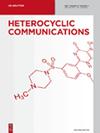Combined XRD-paramagnetic 13C NMR spectroscopy of 1,2,3-triazoles for revealing copper traces in a Huisgen click-chemistry cycloaddition. A model case
IF 1.5
3区 化学
Q3 CHEMISTRY, ORGANIC
引用次数: 0
Abstract
Abstract Copper-catalyzed Alkyne-Azide Cycloaddition (CuAAC) click chemistry robustness has been demonstrated over recent years to produce 1,2,3-triazoles with excellent yields at mild conditions with simple purification methods. However, the consequences of having copper paramagnetic traces in final products, which complicate spectroscopic assignments and can produce inaccurate conclusions, has been scarcely discussed. Herein we present a strategy that combines X-Ray Diffraction (XRD) with 13C- paramagnetic Nuclear Magnetic Resonance spectroscopy, in order to demonstrate the presence of paramagnetic metal traces at standard Huisgen synthesis and purification conditions. We also demonstrate that the derivatization of 1,4-disubstituted-1,2,3-triazoles to produce 1,3,4,-trisubstituted-1,2,3.triazolium salts, promotes an efficient removal of Cu(II/I) moieties. Evidence of paramagnetic metal moieties is given using XRD structural analysis of abnormalities in torsional angles between substituents and the 1,2,3-triazole center, in parallel to 13C- paramagnetic NMR chemical shift and line width analysis. As model systems to demonstrate the importance of characterizing paramagnetic traces, we present the synthesis of novel 1-((3s,5s,7s)-adamantan-1-yl)-4-cyclopropyl-1H-1,2,3-triazole and its derivatized 1-((3s,5s,7s)-adamantan-1-yl)-4-cyclopropyl-3-methyl-1H-[1,2,3]-triazol-3-ium triflate salt.1,2,3-三唑的组合XRD顺磁13C NMR光谱用于揭示Huisgen点击化学环加成中的铜痕量。一个典型案例
摘要近年来,铜催化的炔烃叠氮化物环加成(CuAAC)点击化学稳定性已得到证明,可以用简单的纯化方法在温和的条件下以优异的产率生产1,2,3-三唑。然而,在最终产物中有铜顺磁痕迹的后果几乎没有被讨论,这使光谱分配复杂化,并可能产生不准确的结论。在此,我们提出了一种将X射线衍射(XRD)与13C-顺磁核磁共振波谱相结合的策略,以证明在标准的Huisgen合成和纯化条件下存在顺磁金属痕迹。我们还证明,1,4-二取代-1,2,3-三唑的衍生化产生1,3,4,-三取代-1,23,三唑鎓盐,促进了Cu(II/I)部分的有效去除。使用取代基和1,2,3-三唑中心之间扭转角异常的XRD结构分析,与13C-顺磁NMR化学位移和线宽分析平行,给出了顺磁金属部分的证据。作为证明表征顺磁痕迹重要性的模型系统,我们提出了新的1-((3s,5s,7s)-金刚烷-1-基)-4-环丙基-1H-1,2,3-三唑及其衍生的1-(3s,5s,7s。
本文章由计算机程序翻译,如有差异,请以英文原文为准。
求助全文
约1分钟内获得全文
求助全文
来源期刊

Heterocyclic Communications
化学-有机化学
CiteScore
3.80
自引率
4.30%
发文量
13
审稿时长
1.4 months
期刊介绍:
Heterocyclic Communications (HC) is a bimonthly, peer-reviewed journal publishing preliminary communications, research articles, and reviews on significant developments in all phases of heterocyclic chemistry, including general synthesis, natural products, computational analysis, considerable biological activity and inorganic ring systems. Clear presentation of experimental and computational data is strongly emphasized. Heterocyclic chemistry is a rapidly growing field. By some estimates original research papers in heterocyclic chemistry have increased to more than 60% of the current organic chemistry literature published. This explosive growth is even greater when considering heterocyclic research published in materials science, physical, biophysical, analytical, bioorganic, pharmaceutical, medicinal and natural products journals. There is a need, therefore, for a journal dedicated explicitly to heterocyclic chemistry and the properties of heterocyclic compounds.
 求助内容:
求助内容: 应助结果提醒方式:
应助结果提醒方式:


